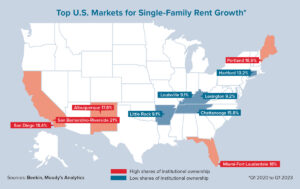Imagine this scenario: An investor spends months scouring the market for the perfect property, issuing countless letters of interest and getting an agreement of sale in place. They obtain contractor quotes, pitch equity partners and secure capital — only to find that the lender decides to back out of the deal at the last minute.
Commercial mortgage brokers know this scenario all too well. Being forced to scramble at the eleventh hour to replace an investor or a lender can have catastrophic repercussions. Unfortunately, due to geopolitical uncertainty, rising interest rates and market volatility, this is becoming a commonplace occurrence in today’s real estate market.
The difference between novice investors and brokers, and those with experience, is how they act once faced with this inevitable circumstance. Having alternative funding options such as rescue capital in one’s back pocket can make the difference between bringing a deal over the finish line or falling short at the very end.
Having alternative funding options such as rescue capital in one’s back pocket can make the difference between bringing a deal over the finish line or falling short at the very end.
There are multiple uses for rescue capital. Additionally, commercial mortgage brokers and their clients should have insights for ensuring that lenders follow through in closing a deal. This will help them avoid being in a position where rescue capital is needed.
Financial life preserver
Rescue capital is a deal’s financial life preserver. It’s a quick capital infusion brought in most often when either a major investor pulls out of a deal or a lender decides not to fund the transaction. It can be the difference between a deal going forward or collapsing.
Because rescue capital is needed within a matter of days, borrowers will typically go through a private lender instead of a traditional bank. Lenders that provide rescue capital can fund transactions without lengthy due-diligence periods, the usual required reports or investment-committee decisions.
In exchange for speed and surety of execution, rescue capital is often more expensive than conventional financing and is only part of the deal for a short period of time. Since rescue capital is only needed to help with closing, it is common for it to be replaced shortly thereafter with conventional financing.
Structures for these types of loans are similar to that of a bridge loan. Leverage is in the 60% to 70% range, with terms as short as one month and as long as five years. Pricing varies based on the property, risk level and time frame, but it is typical for interest rates to be in the high single digits or low double digits.
Case studies
Let’s explore two case studies that describe the use of rescue capital. First, a company looking to acquire an office building in Atlanta almost lost the deal when the original lender decided not to provide funds just days before closing. The investor worked with a small-balance private lender to obtain rescue capital in less than one week. The deal was ultimately successful and the borrower began the process of refinancing the rescue capital with conventional debt.
In a second example, a buyer closing on multifamily housing in Chicago had a nationwide lender lined up to provide financing, but the necessary third-party reports had not come back in time. The lender was not prepared to close without those reports and the seller was not willing to offer an extension.
The buyer had only 10 days to find a new lender and needed a lifeline. Fortunately, a private lender stepped in and was able to provide the capital needed to close. Within two weeks, the nationwide lender provided a loan to refinance the rescue capital.
Finding the appropriate rescue-capital provider is imperative for ensuring that the process goes smoothly. Mortgage brokers should help investors in this process by sharing their recommendations. Brokers and investors should do their due diligence by learning all they can about a capital provider — including details of past deals, talking to others who have worked with the lender, reading online reviews and speaking directly to the lender to understand whether they have the capital ready to be deployed in the necessary time frame.
If an investor gets the feeling that their chosen lender is getting cold feet, they should act fast to find an alternative capital solution. The sooner a borrower acts, the better chance their broker has in securing the needed capital.
Moving parts
Buying real estate is like a big game of chess. There are many moving parts to a property transaction and savvy investors must think five moves ahead.
To avoid having a lender back out in the late stages, a borrower should first and foremost be upfront and realistic about the market in question as well as their financial projections, previous experience and overall goals. The lender will do their due diligence on both the borrower and the property, so it’s always better to provide a clear and honest picture from the start.
For example, if an investor tells a lender that their net worth is $5 million, but in reality it’s only $100,000, then the original term sheet will be discarded. In another instance, an investor might claim that market rents for a property are $2 per square foot, but if in actuality they are only $1 per square foot, then a lender is unlikely to finance the deal.
Even if the borrower perfectly represents their assets, goals, projected earnings and other aspects of the deal, there are many things outside their control that could sway a lender’s decision. These can range from property-level matters such as an appraisal coming in too low, global issues such as war, the broader economy or a pandemic. Understanding national and international affairs is just as important as understanding one’s business plan when searching for a mortgage.
Staying involved
It’s the job of both the broker and the investor to remain involved with their lender throughout the entire process, right up to closing. Borrowers and brokers should speak directly with loan decisionmakers to know their needs regarding documentation, timing and approvals.
Many lenders have investment-committee meetings where they give final approval for loans. The investor has the right to know when these meetings take place and to be updated upon completion. If a lender decides it is no longer comfortable with the initial loan proposal, borrowers have a couple options. First, they can try to get the lender more comfortable with the deal. Maybe the lender would feel better if the leverage was decreased from 70% to 65%, or if a six-month interest reserve was added.
Creativity is often key in closing a deal. By putting in the effort and showing a lender they are committed to the project, a borrower could turn the tides. But if the lender no longer has an interest in providing a loan on the subject property, rescue capital may be the only hope.
● ● ●
Although rescue capital is not the first choice for mortgage brokers or their clients, it can help pull an investor out of a jam if a lender gets cold feet right before closing. To avoid needing rescue capital in the first place, investors should have a solid understanding of the market before requesting funds, frequently check in with their lender and speak directly with decisionmakers. When all is said and done, having a rescue-capital provider lined up as a backup plan is always worthwhile. ●
-
Noah Miller is the founder and president of Royal Palm Funding, a real estate investment firm specializing in first and second mortgages. With a nationwide footprint and a focus on $100k to $5MM loans, Royal Palm Funding is a leader in the small balance mortgage space. Miller is a media contributor to Scotsman Guide, Bloomberg Radio, GlobeSt.com, Commercial Property Executive and others.
View all posts





